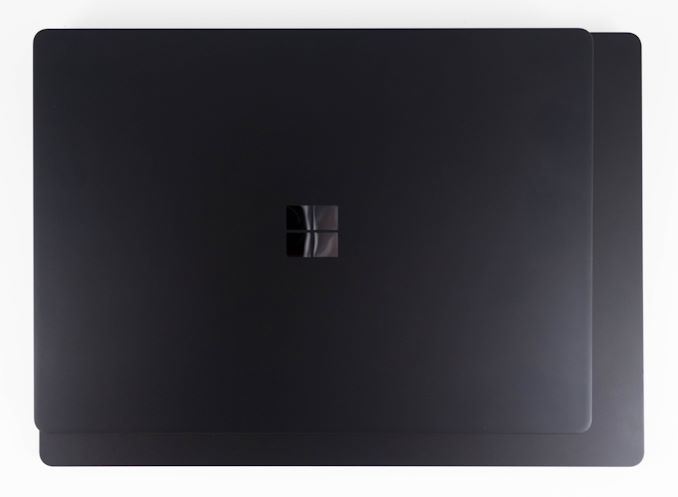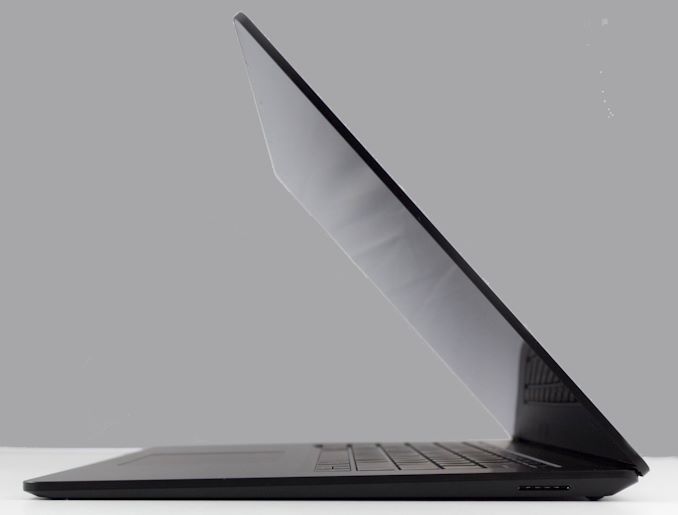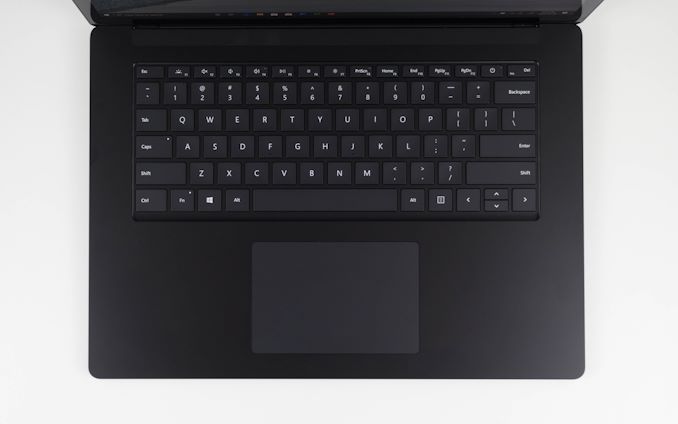The Microsoft Surface Laptop 3 (15-Inch) Review: AMD Ryzen Surface Edition
by Brett Howse on October 21, 2019 9:00 AM EST- Posted in
- Laptops
- AMD
- Microsoft
- Surface
- Ryzen
- Surface Laptop
- Surface Laptop 3
Design
What is perhaps most striking about the new 15-inch Surface Laptop 3 is just how much it mirrors the smaller model. It keeps the striking lines, sharp edges, and thin dimensions of the original 13.5-inch model. It’s an iterative design, but iterative from a design that was already a great looking laptop. Microsoft offers a thicker, heavier, but more powerful laptop in the Surface Book range, but for those that prefer the larger display size, but still like a thin and light, more traditional laptop, this should be a welcome addition to the lineup.
Microsoft doesn’t offer the thinnest display bezels in the industry here, but the extra vertical space from their 3:2 aspect ratio really adds a lot of display real estate, and the display bezels are well-matched on all sides. Some of the thinnest display bezels on the market provide thin sides, a somewhat thicker top, and often a pretty large chin on the bottom, but the Surface Laptop 3 is perfectly proportioned. The extra height at the top also provides room for the Windows Hello IR camera, along with a 720p webcam.
Opening the laptop up takes just a single finger, which was one of the design requirements by the Surface team, and the hinge is incredibly smooth. Despite the light opening force, it still works well with touch too, with some wobble that is to be expected, but not an excessive amount. The opening weight is individually tuned on every single Surface laptop, with a robot on the production line that measures the opening force required on every single device and changes the magnets which hold the display down to adjust the opening pressure. This may sound excessive, but it results in a perfect feel when opening. In order to open the device, the Surface team has not added a scalloped opening for your finger either, since that would break up the lines of the device. Instead, they’ve given the top a miniscule amount of overhang, providing just enough area to let your finger grab it without issue. The Surface Laptop doesn’t offer any of the convertible functionality of literally every other Surface PC, but it is areas like this where the choice to keep this as a more traditional laptop pays dividends.
The weight balance of the Surface Laptop 3 is also spectacular, despite the newer 15-inch model adding dimensions. The 3:2 aspect ratio helps Microsoft here again, squaring up the design compared to the typical 16:9 laptop, so hanging onto it on the side doesn’t quite have the leverage of a wider device. And, despite the larger size, the 15-inch laptop is still incredibly light in the hand, weighing just 3.4 lbs / 1.54 kg, which is only about 0.5 lbs / 250 grams heavier than the 13.5-inch model.
Microsoft has adjusted the keyboard slightly on the Surface Laptop 3, offering a slightly shallower throw, but firming up the keys, while at the same time tuning down the noise as well. Microsoft’s Surface lineup has some of the best keyboards around, and the new Laptop 3 certainly keeps that tradition going. The new key feel is great. The black keys on the review unit also offer great contrast with the white backlighting, which can be adjusted to three levels, meaning it can just be left on all the time, unlike the platinum model which can cause wash-out on the keys if the backlighting is on in a bright environment.
The trackpad on the new Surface Laptop 3 is generously sized, dwarfing the trackpad found on the 15-inch Surface Book 2, but as tends to be the case on Surface devices, the trackpad works flawlessly, and the extra size doesn’t really get in the way when typing thanks to excellent palm rejection.
There’s still not a lot of connectivity on the Surface Laptop, but the addition of USB-C in place of the DisplayPort connector is a tremendous help. The previous model certainly felt constrained with just a single USB port. The lack of Thunderbolt 3 is unfortunate, but only in that it would allow a single cable to drive two UHD displays (the laptop can do it, now, but only in a clunky manner with USB and Surface Connect cables). Adding USB-C does help with travel though since you can charge the device with a USB-C charger, along with most phones. It is worth mentioning that it is great to see that Microsoft has continued to offer the older USB-A port, since most USB devices still use the old connector.
The Surface Laptop 3 is a gorgeous laptop, with beautiful lines, a thin and light frame, and some fantastic attention to detail by the Surface design team. The lack of Alcantara on the 15-inch model is somewhat of a shame, and hopefully they will provide it as an option in the future, since that was one of the unique features of the original device, and it felt great to use. Overall though, Microsoft has done a great job iterating the design of the 13.5-inch laptop and expanding it to the 15-inch form factor, keeping the weight down, the weight balance perfect, and keeping the design aesthetic of the previous model. The new USB-C port is sort of a “finally” moment, but adding it adds a lot of versatility to the device, including the ability to charge on the go without bringing the Surface Connect charger.















91 Comments
View All Comments
Icehawk - Thursday, October 24, 2019 - link
I get that we always want the best but I honestly don't know why it's harped on about how this device "only" does ~315 which is about as fast as a SSD can handle anyway - 1G connects for a single machine just don't matter in real life. More important to me is how reliable the connection is, which according to this review is solid.Eliadbu - Monday, October 21, 2019 - link
I'll give that the GPU is compelling but all other aspects of the APU are mediocre, especially the battery life which worse than average. I would like to see how the ice lake version compares to this APU.I think this machine proved why Intel still dominates the low power/thin and light laptops market.
Irata - Monday, October 21, 2019 - link
Did you look at the system performance benchmarks? Ryzen 5 does pretty well there (second place overall in PC Mark 10) and the list does not include any Core i5, only core i7.The only laptop that has a higher score is the top of the line Surface Book 2 with an i7 plus nVidia dGPU.
The Ryzen model tested here is the base model, btw.
Yes, battery life could certainly be better (although they do not test how well it does under load), but Surface Book Ryzen us not the worst - there are Intel based models that do less well.
phoenix_rizzen - Monday, October 21, 2019 - link
Yeah, if you consider this is the middle-of-the-road APU (R5) from AMD being benched against the top-of-the-line CPUs (i7) from Intel, it does really well. For most of the CPU benchmarks, it's right in the middle of the i7 pack. For most of the GPU benchmarks, it's better than the iGPU, as good as the MX150 dGPU, although not nearly as good (as expected) as the 1060 dGPU.Would be interesting to see how this APU compares to i5 versions of these laptops.
Would also be interesting to see how the R7 APUs compare to the i5 and i7 versions of these laptops.
Eliadbu - Monday, October 21, 2019 - link
this is 8th gen, meaning we are comparing to the past products, you talked about r7 but from what I've seen we are talking 100-200mhz difference (so 5% difference at most ). also the TDP will get up as clock speed goes up which equal to more heat,worse battery life etc. many test that it did perform good is due the GPU as I said it is compelling but is it enough I would say no, and for testing battery life under load I would say while it might have some use cases most people will use the laptop on battery for basic tests like browsing the web, watch videos, edit documents or other light use programs. if the r5/r7 had lower price I would give it more favor but as it stands out it does not give us any discount, it may have been due Microsoft pricing tactics but it does not change the fact. also we need to see how it compares to ICL version of this machine. I would guess it would still have the better GPU but the gap would shrink significantly, and CPU would not be it strong side either.Potato Power - Thursday, October 24, 2019 - link
Microsoft puts a 46Wh battery inside. That explains why the battery life is only so so. Even my cheapy Zenbook has a bigger battery.sorten - Monday, October 21, 2019 - link
Decent showing against previous generation Intel options, meaning it wasn't as far behind as I expected. Unfortunately for AMD, Ice Lake offers better than 2x the iGPU performance of 8th gen chips, and there will also be a minor bump on CPU performance, battery performance, and memory speed.Kishoreshack - Monday, October 21, 2019 - link
People overreacting should understand this is the base model, for a base model it competes very we with top end models of last yearI would be really excited to see higher end models of surface laptop 3
AMD VS INTEL COMPARISON
Felt that surface should have integrated ZEN 2 ARCHITECTURE INTO THESE LAPTOPS
TheinsanegamerN - Monday, October 21, 2019 - link
Except this "base" model has worse IRL GPU performance, worse batery life, and worse wifi. It is a step backwards. AMD GPUs are supposed to be better then intel, but the graphs here show that is not hte case unless power isnt a consideration.Kind of hard for MS to use ZEN 2 ARCHITECTURE APUs when they refuse to make them. AMD is just crippling themselves here.
Fulljack - Tuesday, October 22, 2019 - link
eh, it shows the igpu as the most powerful one, even beating mx150 which is a dgpu on some scenario. too bad the graph still hasn't show Intel gen11 graphics. so I don't get what do you mean by worse irl gpu performance.of course, as expected, it won't beat gtx 1060 due to sheer amount of difference both in tdp and die size.